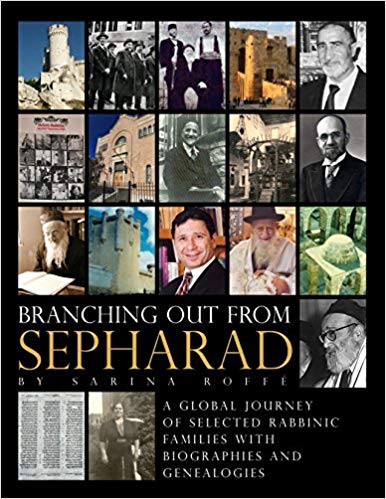
Sarina Roffe
BRANCHING OUT FROM SEPHARAD
A Global Journey of Selected Rabbinic Families with Biographies and Genealogies
Sephardic Heritage Project, 2017, ISBN: 069284502X
Reviewed by Haim Ovadia1
As the author notes in the introduction, Branching out from Sepharad focuses on the genealogy of three prominent rabbinic dynasties of the community frequently referred to as the Jewish Syrian community, which is mostly composed of Jews who emigrated from Aleppo, one of the eyalets, or states, of Greater Syria under the rule of the Ottoman Empire. The author follows the genealogy of the, Kassin, Labaton, and Hedaya families, from their roots in the Iberian Peninsula to the many places to which they have relocated since the nineteenth century. In the process, a brief tour of the history of Jews in Spain is given, starting with a discussion of the contentious term Sephardic Jew. Readers also get a close and more personal look at the Syrian community of Brooklyn through the rich trove of documents and pictures presented in the book.
Roffe’s research is thorough and expansive, and she has traced descendants of these families all over the world, including lost branches in Ireland. The results of her research are remarkable, considering numerous roadblocks such as records in hard to reach archives. Another element which severed ties between family members was the waves of immigration in the nineteenth and twentieth centuries. The confusion created by the custom of naming children after living grandparents, which in turn produces multiple identical first and surnames in the same family, also added to the difficulty of her research.
This book is of extreme value not only to the numerous descendants of these families, who number in the thousands and can find useful information about their origins and relatives, but to many others as well. It is important for the greater Syrian community, regardless of the city from which individuals originated, as these families produced many of the rabbis and community leaders, including the current Chief Rabbi of the Syrian Sephardic community of Brooklyn. Many others including Sephardic Jews who would like to know more about their heritage and Ashkenazi Jews who want to learn more about the Sephardic world will find the book valuable. The book, in fact, has global significance as it shows the intricate ties Jews had, and still have, to the Iberian Peninsula and to large swaths of the Middle East.
In addition to the meticulous genealogical research, which presents dozens of branches and hundreds of individuals, Roffe delights the readers with rare documents, pictures, and findings. Readers can find in the book a legal document from Barcelona, dated to 1492, and signed by Shlomo Kassin2. There are also pictures of the synagogues and community structures in Aleppo, now unfortunately obliterated by the ongoing civil war, immigration documents of some family members, ancient Ketubbot, and more. Of special interest is the chapter on the history of the little-known Syrian Jewish community of Brooklyn, especially the participation of young men from the community in Second World War.
The author presents a letter from then Chief Rabbi Jacob S. Kassin3 to the Jewish Welfare Board, dated March 17, 1941, in which the Rabbi requests kosher food for the recruits of the community. He writes that “our community, of which Magen David congregation is the center, is composed of 5,000 people, of whom many are of draft age and very orthodox (p. 117).” This letter, along with many other documents in the book, sheds light on the history of Syrian Jews in America and helps the reader better understand this rather insulated community.
In conclusion, Sarina Roffe has conducted a thorough and meticulous genealogical research. In addition to the many revelations and details about the Kassin, Hedaya, and Labaton families, she enriches the readers’ knowledge regarding the history of Sephardic Jews, in general, and Jews of Aleppo, in particular.
1 Rabbi Haim Ovadia is the rabbi of Magen David Sephardic Congregation of the Greater Washington area. He represents the tenth generation of rabbis in his family from Aleppo.
2 Señor Shlomo Kassin was a wealthy merchant who left Spain for Aleppo 1540. He became the head of the Aleppo Jewish community where he became devoted to Torah study.
3 Rabbi Jacob S. Kassin (1900-1994) became the Chief Rabbi of Magen David Congregation of Brooklyn in 1933. For 62 years, Rabbi Kassin was a strong supporter of Sephardic heritage.
Copyright by Sephardic Horizons, all rights reserved. ISSN Number 2158-1800
